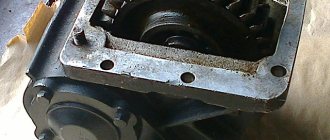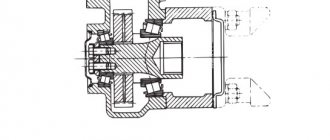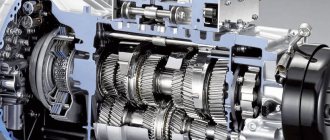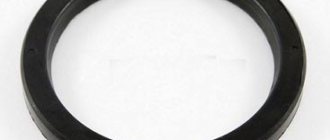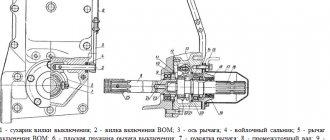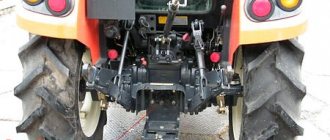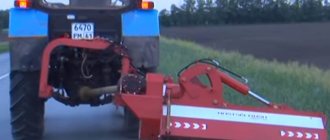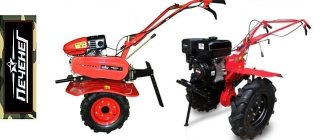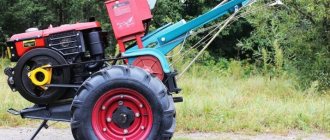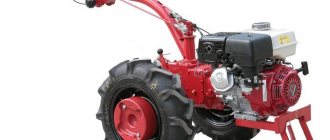Pump NSh-50 INSTEAD OF NSh-32 AT MTZ
If anyone installed an NSh-50 pump on an MTZ-80, tell us how its drive worked. Did anything go wrong? There is a desire to install an NSh-50 on an MTZ excavator loader to speed up its work. There is no problem, I’ll increase the diameter and replace the hoses with Dtovskie
The question is whether it will hold up or not. I’ll share my experience of replacing NSh 32 with 50. It was a long time ago, I don’t remember exactly, but it seems that the oil supply pipes in the thicker NSh 50 have to be replaced. And I didn’t seem to notice the difference, but we were new. Then, after some time, the distributor was replaced after repair; the same hydraulics were not working properly. And then they changed the kit and installed a new nsh 32 and a new distributor, that’s when I felt the power of hydraulics. But this is just my case, see for yourself. The conclusion is that a lot depends on the distributor. you can throw 50 but the problem was in the distributor
If anyone installed an NSh-50 pump on an MTZ-80, tell us how its drive worked. Did anything go wrong? There is a desire to install an NSh-50 on an MTZ excavator loader to speed up its work. There is no problem, I’ll increase the diameter and replace the hoses with Dtovskie The question will stand, will not stand
I also want to solve this problem, I’m preparing fittings and other bells and whistles, I want to install an MP-80 distributor
installed, works normally, turn of the boom has become faster, it needs to work faster, the return line from R 80 is thicker, the oil doesn’t have time to escape, tears the aluminum cover or crushes the gasket, the pressure created is the same for all pumps, the NSh10 and the NSh 100, the difference is how much oil it pumps in a minute
I’ll share my experience in replacing NSh 32 with 50. It was a long time ago, I don’t remember exactly, but it seems that the oil supply pipes in the thicker NSh 50 have to be replaced. And I didn’t seem to notice the difference, but we were new. Then, after some time, the distributor was replaced after repair; the same hydraulics were not working properly. And then they changed the kit and installed a new nsh 32 and a new distributor, that’s when I felt the power of hydraulics. But this is just my case, see for yourself. The conclusion is that a lot depends on the distributor. you can throw 50 but the problem was in the distributor
I tried installing a new distributor R-80 and a new pump NSh-32, it works a little better, but very slowly, all the R-80 is in oil. Today I was loading sand into a Kamaz truck, and at a temperature of 29 degrees it generally mooed, if the front loader bucket was scooped up a little fuller and didn’t lift it, I had to dump it. So, you still need to switch to NSh-50. By the way, I talked to the Terex driver, there are two pumps 2*80 l/min = 160 l/min. So, consider for yourself the ratio 160/32 = - this is more than five times and naturally all the working organs work 3 times faster, that’s for sure. Why does no one want to share their experience or no one from the forum has done this. I purchased a backhoe loader with 4 years of operation, and when I searched and talked with sellers, everyone was selling it precisely for this reason, that there was no performance whatsoever!
NSh-32 for MTZ
In every Belarusian tractor of the MTZ brand - 80, 82 and its later versions, be it urban working (harvesting) equipment, construction, road or agricultural (depending on the attachment), one type of device is installed - NSh (gear pump) high pressure, designed for operation in a hydraulic system in the form of an oil (liquid) supercharger.
Types of NSh pumps: which one to choose for the hydraulics of the MTZ tractor
MTZ 80 and 82 tractors are equipped with NSh32 hydraulic oil pumps. But you can replace them with other models with different technical characteristics, if necessary.
Pumps NSh6, NSh10, NSh32, NSh50 or NSh100 are suitable for the hydraulic system of the tractor. The design features of the housing, the location of the inlet and outlet openings and other characteristics are the same, so replacement is possible without alterations, installation of adapters, etc. In other words, these units are interchangeable, so you can choose the model that is better suited for performing specific tasks on the tractor.
The brand of the gear pump indicates the displacement of the housing. Thus, for oil pumps from NSh6 to NSh100, the working volume will vary from 6 to 100 cm3.
All units have the same pressure:
- sucked oil – 0.018-0.15 MPa;
- oil output - 16 MPa.
Due to different working volumes, NSh oil pumps for hydraulics have different performance. It is 16.3 l/min for low-power NSh6 and can reach up to 173 l/min for the most powerful NSh100. Accordingly, depending on this, the power will vary - from 6.8 to 80.1 kW.
As for the operating conditions, they are the same for all MTZ hydraulic oil pumps: from -50 to +60 degrees.
To make it easier for you to choose the brand of hydraulic oil pump, we present the main technical characteristics of different NSh pumps. They are presented in the table below.
Types, differences and features
Depending on the tractor’s attachments, two types of hydraulic drives can be installed on it, although each of them is still hydraulic, because in essence they perform equivalent tasks:
The NSh - 10 pump is necessary for the hydraulic system to work with buckets and loaders (excavator attachments or KUNs). In other words, it is designed to perform any actions in the horizontal plane.
The NSh-32 pump is more suitable for attachments designed to work in a vertical plane (graders, dumps, bulldozers), although it can also be used for bucket sheds. The most common action this type performs is driving booms and grapples.
Related Posts
What rotation are the pumps installed on the PE-F-1B or BM grab loader from the factory?
Guys, tell me, what rotation pumps are installed on the PE-F-1B or BM grab loader from the factory?
Why do I have difficulty turning the steering wheel on the MTZ-82.1? I went through the power steering, replaced the power steering distributor (valve) with a new one, replaced the NSh 10 pump. No sense.
Good afternoon, I need help. On MTZ - 82.1, I can hardly turn the steering wheel in place. In general, I completely went through the power steering, replaced the power steering distributor (valve) with a new one, replaced the NSh 10 pump with a new one. No matter how I adjusted it, it was of no use. What could it be?
Why does the new generation MTZ 82.1 transfer oil from the hydraulic tank to the engine? We replaced the nsh-10 pump.
Colleagues, please tell me the oil on the new generation MTZ 82.1 distills from the hydraulic tank to the engine, we changed the nsh-10 pump, everything is fine for a week and then it starts distilling again in a new way.
I installed a dispenser 160, NSh-10 at YuMZ. Why does the steering wheel turn by itself? It’s a little tight in the middle, but it stays in place, and with a slight turn it tightens itself to the end.
I installed a dispenser 160, NSh-10 at YuMZ. Why does the steering wheel turn by itself? It’s a little tight in the middle, but it stays in place, and with a slight turn it tightens itself to the end. This process can be controlled, but it still shouldn’t be like this, why is he trying to reverse it?
What is the direction of rotation of the CO-7 compressor?
Who knows what direction of rotation of the CO-7 compressor?
What rotation of this nsh is suitable for MTZ or not?
Good day. Tell me what rotation is suitable for MTZ or not?
Why does the MTZ 82.1 hydraulic pump get hot?
Good afternoon everyone. Question. Why does the MTZ 82.1 hydraulic pump get hot?
MTZ 82.1 Why did the hydraulics stop working? Either the pump gets hot or it doesn’t lift at all. The pump is new. The valve on the distributor was regulated.
Good afternoon. Guys, tell me, who has encountered such a problem? MTZ 82.1 The hydraulics stopped working, the pump gets hot, or it doesn’t lift at all. The pump is new. The valve on the distributor was regulated. Thanks in advance for your answers.
What engine are the rings from? Costs d243 euros 2 cylinder head d245 2013 MTZ 82.1
Who knows what engine the rings are from? Costs d243 euros 2 cylinder head d245 2013 MTZ 82.1
Operating principle of NS
In fact, the operating principle of all NSh brand systems is almost the same and, having only design features depending on the application in specific areas of technology, it looks like a device that transfers (squeezes out) fluid into the hydraulic system.
It is not at all difficult to imagine how the rotating rotors (driver and driven) concentrate the vacuum on the inlet side, as a result of which (under pressure) the grooves and voids are filled with the pumped liquid.
To understand the principle of operation visually, just look at the detailed diagram of the NS shown in the figure:
1. Rear cover; 2. O-ring; 3. Support bushing; 4. Pump housing; 5. Rubber cuff; 6. Front cover; 7. Reinforced cuff; 8. Ring; 10. Plate; 11. Flange; 12. Bolt; 13. Washer; 14. Leading rotor; 15. Driven rotor.
However, despite the relative primitiveness of the device and the ease of its operation, any tractor owner and/or mechanic needs to know two important conditions - the accuracy of choosing a pump for a specific equipment and the causes of various malfunctions in its operation.
Subtleties of choice
1. When selecting and installing the NS, you need to find out the direction of rotation (right or left), for which you look at its shape (round or flat).
There is a marking on the casings of all pumps, where the letters UK, U, UV, M indicate a flat pump, and the letter A indicates that it is round.
All round ones are used under increased hydraulic loads; they are more expensive than flat ones and have improved characteristics.
2. Be sure to pay attention to the typical connection to the drive. Depending on the shaft design (syringe or keyed), it can be different.
Malfunctions and possible causes
1. Lack or lack of oil being pumped into the hydraulic system.
- possible leakage;
- drive is broken;
- the pump is worn out.
2. Foam appears in the hydraulic tank or air is forced into the hydraulic system.
- the pipeline is depressurized;
- low oil temperature;
- wear of the drive cuff.
3. Rumble and vibration when the pump is running.
- weak fastening of the pipeline and/or other system components;
- wear of the drive coupling;
- vibration of shut-off valves.
4. Lack of maximum pressure during operation.
- contaminated valve spool;
- skewed valve adjustment;
- general pump wear.
5. Periodic overheating of the pump.
- filter clogging;
- work at increased power above normal;
- low oil level in the hydraulic tank.
Tips and tricks
In order for the NS pump to work like a Swiss chronometer for a long time and properly, do not exceed its limited time:
- agricultural machinery no more than 4000 hours;
- city no more than 1000 hours;
- industrial and construction no more than 3000 hours.
When replacing a pump, be sure to change the filter, which will guarantee a reduction in the cost of ongoing repairs and reduce equipment downtime.
Use only original spare parts and components - this will protect the entire unit from wear and tear and increase the profitability of the work.
Structurally, NSh gear pumps are divided into flat, round and universal NSh pumps. And also NSh gear pumps come in right and left rotation, and single-section, two-section and three-section (the last two types are called tandem or paired NSh). Determining the rotation of a gear pump is not difficult; to do this, you need to place it with the shaft (drive) up. If it rotates clockwise, then it is right-handed, and if it rotates counterclockwise, then it is left-handed.
Malfunctions of the MTZ hydraulic pump and methods for eliminating them
The pressure does not rise at the pump outlet
A drop in outlet pressure usually indicates an insufficient amount of fluid. It may be lost as a result of loss of elasticity of the seals, or too little of it was initially poured into the hydraulic tank.
Foam comes through the throat of the hydraulic tank
Foam forms when air is sucked into the tank through the seals. In this case, you need to replace the worn gaskets.
Oil seeps through joints
The appearance of oil smudges in the places where the oil lines are connected can be caused by the fixing fasteners being too tightly tightened. To eliminate oil seepage, try loosening the connections.
The hydraulic tank is heating up
A failed spool or bypass valve can cause the hydraulic system tank to heat up. To eliminate the defect, you need to check the operation of these parts and, if necessary, replace them.
The hydraulic oil pump makes a loud noise when operating.
Increasing noise during operation of the MTZ hydraulic pump usually indicates an insufficient level of mineral oil. To eliminate the malfunction, you need to check the tightness of the connections and the integrity of the route, and also top up the fluid to the recommended level.
NSh on MTZ 82.1
Depending on its purpose, a gear pump has various features and parameters. For example, NSh-10 is used on tractors with excavator attachments. Its actions must occur in a horizontal plane. An NSh pump such as NSh-32 is suitable for equipment with attachments that operate in a vertical plane. These can also be bulldozers, blades, graders, bucket sheds. This type of equipment is required to drive the grapples and booms.
The design of all NSs is similar to each other and has a single operating principle. There may be discrepancies in the structural elements and types of equipment that include them. In turn, a gear pump is a unit that transmits fluid in a hydraulic system. Due to rotation, the driving and driven rotors concentrate vacuum on the input side, as a result of which the voids and grooves are filled with liquid as a result of the resulting pressure.
If we consider the structure of the unit, it does not seem complicated. But during operation, difficulties may arise if the mechanic does not have sufficient knowledge about the intricacies of choosing a pump depending on the equipment being used.
In conditions of increased hydraulic load, round pumps are used. There are also flat ones. The price and performance characteristics of the former are significantly higher than the latter models.
The typical connection to the drive depends on the shaft design. This is another important factor. In turn, the design can be syringe or keyed.
Explanation of the markings (designations) of the gear pump
Let's look at the example of the NSh-32U-3-L gear pump:
NSh - gear pump
32 — pump working volume indicated in cubic centimeters. (in one word, this pump will pump 32 liters of working fluid in minutes)
U - modification (universal)
L - Indicates the direction of rotation. If there is no letter “L”, then the pump is of right rotation. Also, many factories put a drop of blue paint on right-hand rotation pumps.
Table for decoding the designation (marking) of the NSh-32U-3-L pump
content .. 111 112 113 114 115 116 117 118 119 120 ..OIL PUMP NSh-10E FOR HYDRAULIC SYSTEM OF TRACTOR T-25
The NSh-10E gear oil pump operates at an operating pressure of 100 kg/cm2 and has a capacity of 14 liters per minute if its drive shaft rotates at a speed of 1565 rpm.
The pump (Fig. 94) consists of a housing 11, a cover 4, two drive gears 13 and a driven 10, two bearings 9 and 12, rubber seals 8 and a plate 7.
A rubber sealing ring 6 is installed between the body and the cover. The cover is fixed relative to the body with two pins 5 and secured to it with eight bolts.
The pump housing has bores that house bearings and gears. Bearings serve as supports for gear shafts and also seal the end surfaces of the rims. The bearings are paired bushings. Each bearing has two borings for the journals of the mating gears.
Both bearings 9 and 12 are floating (self-aligning) and are pressed to the ends of the gears independently under the influence of oil pressure.
High-pressure oil from the injection cavity is supplied through the channel between the bearings and the housing, pressing them against the ends of the gears. At the same time, the working ends of the bearings are exposed to high oil pressure from the discharge cavity.
The bearings are evenly pressed against the ends of the gears, thereby eliminating the gaps that arise as a result of wear of the ends of the gears and bearings.
The gear journals are lubricated from the suction cavity through spiral grooves located in the bearing bores on the non-loaded side.
The drive end of the drive gear is sealed with a frame oil seal 14 with a self-tightening cuff.
The NSh-10E pump is non-reversible. It can be used for left-hand rotation only or right-hand rotation only. The T-25 tractor uses a left-hand rotation pump (counterclockwise when viewed from the drive shaft).
Straight couplings are installed on the side surfaces of the body (unlike the DT-20 tractor, where angular couplings are used) to connect the suction and discharge pipelines. The inscription “Input” is cast on the body on the side of the suction hole.
The oil pump is secured with four bolts to the drive housing, which is mounted on the connecting housing on the right side of the tractor.
The drive consists (Fig. 94) of a housing 26, a gear transmission and an enabling device. The driven gear 25, installed in the drive housing on two bearings 22, is in constant mesh with a gear located in the connecting housing of the tractor behind the clutch release device and connected directly to the engine flywheel. Thus, this gear, and therefore gear 25, is constantly rotating when the engine is running.
A ball clutch is used to disconnect the pump.
The leading element of the coupling is the roller 21. The gear 25 is secured to it using a key 20.
At the rear end of the roller there is a hinge holder. Four balls 16 are placed in its holes.
Inside the holder there is a splined bushing 17, it is installed in the splined hole
hydraulic pump drive shaft. On the outer surface of the sleeve 17 there are four grooves into which balls 16 can fit. They are buried in the grooves of the sleeve 17 and are held in this position by the inner surface of the sleeve.
This position corresponds to the engaged state of the clutch, in which the balls close the holder on the roller 21 with the sleeve 17 and transmit rotation from the drive to the hydraulic pump.
If you use fork 27 to move the bushing to the left, then a recess of larger diameter will be located opposite the balls. This allows the balls, under the influence of centrifugal forces, to disengage with the grooves of the sleeve 17 and disconnect the gear 25 from the hydraulic pump shaft (on position).
Fork 27 sits on shaft 2 and is clamped with a bolt
3. At the outer end of the roller there is a handle with a button that locks the roller in the on or off position. It is allowed to turn on the pump only with the engine running, since when the roller 21 with the holder does not rotate, the balls may not coincide with the grooves on the sleeve and will prevent the sleeve 17 from moving to the right.
Rice. 94. Oil pump and its drive: 1 - test; 2 — power fork roller; 3 - coupling bolt; 4 — hydraulic pump cover; 5—locating pin; 6 - sealing ring; 7 - plate; 8 — figured cuff; 9 — front bearing; 10— driven gear; 11—hydraulic pump housing; 12 — rear bearing; 13 - drive gear with shaft; 14 — frame oil seal; 15 - movable coupling; 16 - ball; 17 — splined bushing; 18 — gasket; 19—locating pin; 20 - segment key; 21 — drive roller with ball holder; 22 - ball bearing; 23 - cover; 24 - bolt; 25 — driven gear; 2b - drive housing; 27 — power plug.
content .. 111 112 113 114 115 116 117 118 119 120 ..
